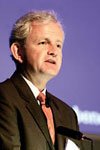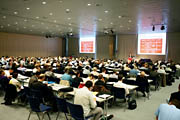
With 608 conference participants (versus 570 in 2003) from 33 countries, plus approximately 230 "exhibition only" visitors (200 in 2003), RadTech Europe 2005 had grown substantially compared to its predecessor two years ago in Berlin - this growth being evidence of the ongoing interest in UV/EB techniques for various coating, adhesives and printing applications.
After the show, the vast majority of the 50 exhibitors said that they were very pleased with the turnout and caliber of the visitors. Naturally, the stands were most-often besieged during breaks in the conference. As one exhibitor pointed out, however, important discussions had additionally taken place with customers and interested parties in the quieter phases in between.
One positive aspect repeatedly pointed out by the conference participants was the high technical expertise of the speakers and their papers, the vast majority of which presented in-depth, profound studies of practical relevance. Most of the papers, naturally, disclosed important technical progress in established radcure markets - but several fundamentally new developments, quantum leaps, so to speak, were also presented, and provided much food for thought and debate.
As in previous years, some exhibitors expressed disappointment at the low turnout of (potential) UV/EB end users - this category of visitors obviously remains difficult to attract in large numbers.
A European UV/EB Safety Protocol - Now for Coatings as Well
Against this background, then, the ceremonial signing of the UV/EB protocol for the European printing and coating industry during the opening session of the conference assumed even greater importance. The signing of this protocol is the culmination of collaborative work originally initiated in 1995 between German and British health and safety organizations for the printing industry. With the new protocol, European health organizations and industrial associations pledge to observe a specific catalogue of "Best Practice" measures during the application of radiation-curing printing inks and - for the first time - also for coatings. This agreement should help pave the way for a more widespread use of UV coatings.Growth to Remain High in the Future - Strongest in Asia
In the conference's plenary session, Wolfgang Paulus (BASF) presented the current state of development and trends in UV/EB technology. He forecast, on the basis of a BASF study, that the high growth enjoyed by the radiation-curing market over the last 10 years would remain more or less unchecked until 2015, averaging 8-9% annually in Europe and NAFTA, and 12-13% in Asia. From these figures, it may be concluded that Asia will essentially draw level with Europe in 2015, by which time each will amount to somewhat more than 130,000 t/a (tonnages in 2004: Europe 63,200, NAFTA 64,700, Asia 40,000).Innovation Awards for New Applications
In its search for novel radcure applications, the RadTech Europe Association had for the second time sponsored its Innovation Awards and honored the winners in the plenary session.- The "Printing and Packaging" category was won by Punchgraphics International NV for a UV-curable powder toner.
- Top honors in the "Industrial Coatings and Adhesives" section went to Tikkurila Coatings Oy for its development of a waterborne UV furniture coating.
- Finally, the award in the "Automotive and Specialities" category went to Mediterranea de Investigaciones Cientificas, a subsidiary of the NO&LO group, for its anti-graffiti UV coating for ceramics, glass and marble.

Paul Dufour Award: Radiation-Curing Car Refinish Clearcoat
A possible quantum leap in new UV/EB applications was presented by Nazire Dogan of Akzo Nobel Car Refinishes, who received the Paul Dufour Award for the best conference paper. This concerned a car refinish clearcoat that can be cured with manual UV-A emitters. The high-solids, 2K formulation is based on a thiol-polyisocyanate curing mechanism, catalyzed by a photolatent amine base developed by Ciba Specialty Chemicals.Plasma UV for 3D Curing
A hotly debated presentation was that by Tunja Jung (Ciba), who reported about a project on the plasma-UV curing of coatings on 3D objects, ultimately aiming at car body OEM coatings.* The plasma, which emits intense UV radiation produced by discharge processes, is induced by microwaves in a process gas at 0.06 mbar. Advantage: the plasma light source surrounds the object uniformly, without any shadow zones. The method has already been demonstrated successfully in the laboratory as an alternative to dual-cure systems. Since a vacuum is needed, upgrading for large objects poses a challenge. However, a full-size pilot plant for car bodies has been in operation since September 2005.LEDs Looking for Applications
LEDs as UV sources have been under discussion for some time and are now poised for first applications, e.g. in UV-curing ink-jet inks. Richard Little (Jenton International) and Paul Mills (Phoseon Technologies) demonstrated the latest possibilities. Their advantages: they have a very long service life, emit no IR radiation, can be arrayed in special geometries, deliver their UV output instantaneously without the need for warm-up, and can be pulsed in the millisecond range as required. Their limitations: they are still relatively expensive and cannot yet rival the power density of modern UV vacuum lamps. Little showed that the light output from LEDs can be increased by highly effective cooling, permitting greater current loading of the diodes. Furthermore, installing each single LED into optimized reflectors enables the light emitted "backwards" to be collected and steered towards the coating.
As Mills pointed out, it is now necessary to find out which chemical systems are cured effectively by LEDs and to adjust formulations to the new light sources.

Urethane Acrylates Without Isocyanate Chemistry
Jurgen van Holen (Cytex Surface Specialties) discussed the possibilities of new "non-NCO" urethane acrylates that are not produced via isocyanates, but from polyamines by reaction with cyclic carbonates and subsequent transesterification with methyl methacrylate. The resultant resins avoid the costs incurred when isocyanates are handled, are highly reactive and can exhibit very low intrinsic viscosity - indeed, some of the non-NCO structures cannot even be made from isocyanates.UV Cure Without Photoinitiators
Michael Gould (Ashland Specialty Chemical) questioned the use of photoinitiators. He presented new self-initiating UV resins that are based on the Michael addition of b-ketoesters with polyacrylates and require either very little additional initiator or none at all. Having been first presented in 2002, such resins are now in their third generation and, according to Gould, are notable for their very low viscosities, a "programmable polydispersity" and a competitive high reactivity.Matte but Transparent
Matting of 100% UV coatings with silica particles is still proving to be a challenge because the coating films hardly shrink at all during curing, making it very difficult to roughen the surface with matting agents. Hans-Dieter Christian (Degussa) showed in his study that the matting efficiency with silica particles is in fact intricately dependent on a large number of parameters. Thus, it is crucially affected by the reactivity, double-bond content and viscosity of the oligomers employed, but also by the substrate, its specific heat capacity and its thermal conductivity. In this regard, Christian presented new, polysiloxane-modified pyrogenic silica particles that combine good matting efficiency with high transparency of the coatings films and appealing rheological behavior.The conference proceedings (2 volumes, 1124 pages) are still available from Vincentz Network, Mareike Bäumlein, Tel. +49 511 9910-273, Fax +49 511 9910-279, or e-mail mareike.baeumlein@coatings.de.

Report Abusive Comment